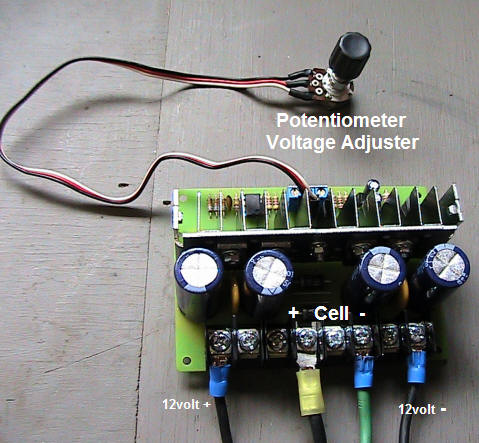Supply Voltage: 12 to 36 Volts
DC
Load Current: 80 AMPS Continuously, with Resistance and Inductive
loads
120 AMPS for short periods of acceleration (up to 10 sec.)
Range of regulation: PWM 0 to 100% of power
Two models are available: Fixed frequency of 1.6 kHz, and Variable frequency
of 13kHz to 23kHz.
Overheating protection: When the module is overloaded, power is
automatically
decreased, in order to protect the mosfet transistors from destruction.
This is NOT A KIT; this module is fully
assembled as shown in the picture.
Will control loads of up to 3 Kilowatts. Comes with instructions.
Note:
There are 2 connections for power, and 2 connections for load, each of which
has 2 screw-down terminals. That way, 2 thinner wires or a twinline can be
used, instead of a single thick wire, for each lead. And these connections
are clearly marked on the bottom of the board.

TIPS:
If you plan on running up
to 30 amps, then your PWM needs to be rated for at least 30 Amps
"Continuous". That is "continuous 30 amps". That means it can be operated
at 30 amps continuously without overloading and getting hot. There are a
lot of 30 amperes out there on ebay - but they are not rated continuous;
non that I could find.
Let me give you an example
of what I mean. I use an 80 amp PWM. It is rated at 80 amps continuous. It
can handle 120 amps for 10 seconds. It can handle 160 amps maximum/peak.
In other words amperage can fluctuate up to 160 amps but can not stay
there. The PWM can not maintain continuous operation higher than 80 amps.
For protection, my PWM has a feature called Thermal Shutdown. If the
current runs 120 amps for more than 10 seconds, it gets hot and goes into
thermal shutdown. The mosfet transistors have to cool off before it can be
used again.
So you have a few things
to look for when you shop for a DC PWM. Keep in mind, it is better to have
"More" Amperage capability - than to "Not" have enough.
The following
specifications are a must - in my opinion:
- Input voltage: must be
able to use 12 to 15 volts dc as an input voltage
- Amperage Rating:
30 Amps Continuous (example)
- Maximum/Peak Amperage
- Thermal Protection
These features are an
extra benefit:
- Frequency Control
(Meyers and Boyce used frequency to help break down the water)
- Remote Potentiometer
Control
- Pulse Control (pulses
per second)
If your potentiometer is
on your PWMs circuit board, it can be removed and replaced with a remote
one. Unsolder the potentiometer and solder 3 wires in its place. extend
those wires to your dash. You may be able to use the old potentiometer. If
not, Radioshack has some. Try to match the resistance rating; usually 10k
Ohms. You can find a friend to help you with this. If not, a TV repair
shop can help with the circuit board. Better yet, get a PWM that does what
you want - to start with.
|